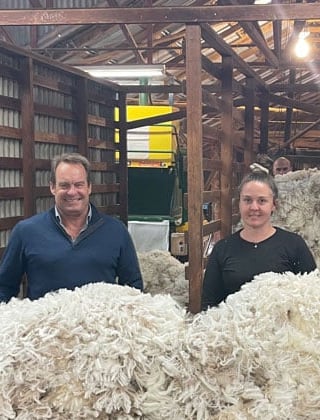Welcome to Australian Wool Innovation, a hub for the woolgrowers of Australia.
Not a woolgrower? Looking for information about wool products, wool care or wool processing?
The Woolmark Company is the global authority on wool. Visit Woolmark.com instead.
Biological wool harvesting on show

Woolgrowers in Western Australia had the opportunity to view biological wool harvesting at a demonstration held at Katanning at the end of October. A similar demonstration day was held at Conargo in NSW at the start of September.

Professor Phil Hynd of the University of Adelaide speaking to woolgrowers at Katanning, WA.
As previously reported in Beyond the Bale, AWI is funding promising research by the University of Adelaide into a new opportunity for biological harvesting of wool that generates a weakened zone at the base of the wool fibre but, importantly, enables the fleece to remain on the sheep without a net until the wool can be mechanically removed.
With R&D into the innovation progressing well, woolgrowers attending the Sheep Field Day at the Department of Primary Industries and Regional Development’s (DPIRD’s) Katanning Research Station on 26 October were able to talk to the University of Adelaide researchers and see the results, to date, on sheep.
“I think giving these demonstrations have been a real positive for us because we can feel the real excitement of the producers and the fact that they understand the need for what we’re trying to do. We'll plow on now with some confidence,” said chief researcher Professor Phil Hynd of the University of Adelaide.
The next phase of AWI’s biological wool harvesting project is the selection and funding of proposals to develop manual/semi/fully automated technology to harvest the weakened wool, ie a device that applies a force to separate the wool from the body of the sheep. This could be in the form of a handpiece for manual wool removal through to a more comprehensive automated system.

An example of a treated sheep that has had some of its wool harvested, for demonstration purposes.
AWI issued a Request for Proposals (RFP) world-wide in October for the purpose of obtaining responses from engineering companies, universities, entrepreneurs, start-ups and other organisations – see www.wool.com/on-farm-research. Applications close on 22 December.
Biological wool harvesting is an example of the multi-pronged approach that AWI is taking to make wool harvesting easier and more cost-effective for woolgrowers and the industry.
More information: www.wool.com/wool-harvesting-innovation
This article appeared in the December 2023 edition of AWI’s Beyond the Bale magazine. Reproduction of the article is encouraged.















